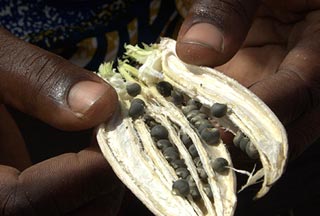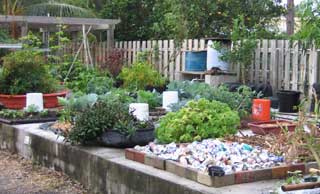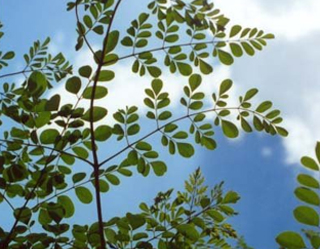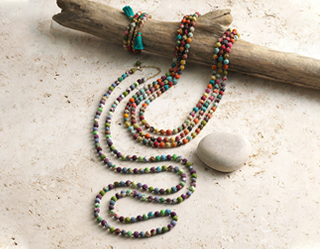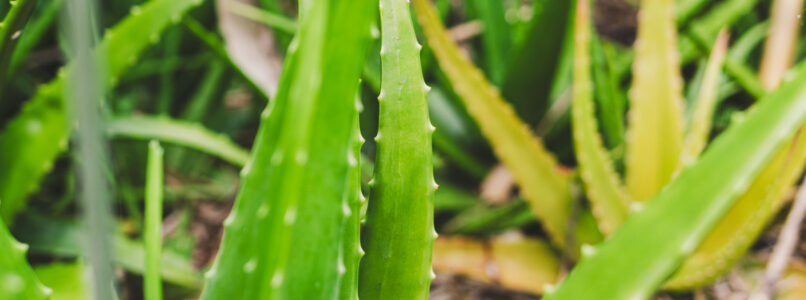Aloe vera is a well-known plant, but there’s plenty of health potential that’s left untapped by many. Here are some tips and tricks for harvesting and using this incredible plant.
By Sarah Bakeman
From Mesopotamia and Ancient Egypt to the aisles of Walgreens, aloe vera continues to be one of the most commonly-used medicinal plants in the world. And here at ECHO, we are lucky enough to have some growing in the Semi-Arid region of our Florida campus.
The first time I saw an aloe vera plant in real life, I was shocked to see the pointy succulent leaves shooting in all directions. I primarily associated aloe vera with bright green, chilled gel that I bought in case my sunscreen application wasn’t thorough enough. When I came to ECHO, the experts here and on ECHOcommunity were kind enough to show me the plant and how to harvest it.
From there, I’ve learned that it is a versatile medicinal plant with hundreds of applications. Aloe vera is high in fiber, vitamin C, vitamin A, vitamin E, beta-carotene, folic acid, calcium, and magnesium. That was a lot of commas, but it shows just how amazing this plant is!
At ECHO, we love to use everything we grow for some greater purpose. I’d like to share with you how I harvest and use aloe vera!
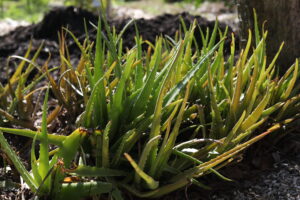
Removing the gel
It’s surprisingly easy to remove the gel from an aloe vera leaf. After peeling and cutting around the pits of the mangoes that are in season here at ECHO, processing this aloe vera felt like an easy break! It was a quick, simple, and rewarding process.

First, if the base of the leaf is still on, you should cut that off. When I grabbed the leaf from the Semi-Arid region of ECHO’s farm, I cut it from the base. Once I got the leaf to my house, I went ahead and rinsed it off.
You might notice a yellowish fluid leaking out after removing the base. This is called aloin, and it’s the sap of the aloe plant. I didn’t realize aloe plants had sap until an ECHO expert informed me! Pretty cool, right? But for our purposes, we won’t want to use this aloin. While it’s not toxic, it has a bitter taste and might cause an upset stomach. The best practice is to just dispose of it.
To get rid of the sap, you simply stand the leaf upright. This can be done in any container or your sink. Leave it for about 10 minutes, and when you come back it should be ready to cut!
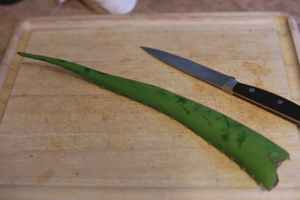
Grab your cutting board and knife, and cut along the serrated edges along the sides of the leaf. This will make the next step much easier.
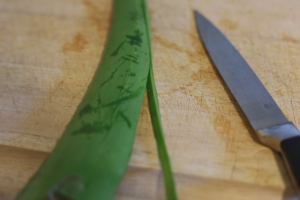
Once the serrated edges are gone, run the knife under the top skin of the leaf, separating it from the gel underneath. Be careful! The gel is slippery. After that, run the knife under the gel to separate it from the bottom of the leaf. It also works to use a spoon and scoop the gel out.
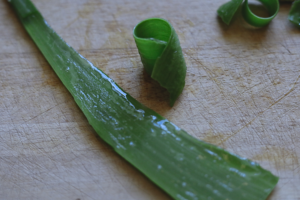
If you missed any green spots, cut those off. Similarly, if you see any reddish-brown spots, those are remnants of the sap. You can either cut or rinse those off.

At this point, you’ll have a beautiful, translucent gel. You’ll want to put it in an airtight container in the fridge, but there are a few options for how to do that. You could just stick the whole strip in a container, but ECHO’s experts like to either puree the gel or cut it into cubes before storing. A puree will make the aloe easier to use for skincare or smoothies. If you don’t plan on using it right away, you could blend the aloe and pour it into an ice cube tray! This would help it last longer.
And that gets me onto the next topic. How do you use aloe vera? Of course, most people have seen the store-bought, green gel that helps with sunburns. But there are so many more uses for freshly-harvested aloe plants!
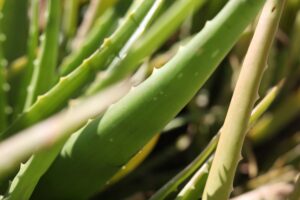
Moisturizer
Aloe vera has well-documented benefits for the skin beyond just soothing sunburn. It can easily be incorporated into your daily skincare routine as a face and body moisturizer. Some ECHO experts here on our Florida farm harvest aloe weekly for personal skincare use. Not only does it have hydrating properties, but it will also absorb into your skin nicely. As is true for other moisturizers, just avoid getting it in your eyes! For a more intense moisturizer, there’s plenty of ways to make aloe face masks.
Makeup remover
That’s right, you can start your day with an aloe as a moisturizer and end it with aloe as a makeup remover. It’s easy to do! Just rub the aloe gel on your face. You’ll notice the makeup starts to loosen off of your skin and mix with the gel. Take a towel or cotton pad and wipe your face clean, and rinse off any remaining gel with water.
Exfoliant
An aloe sugar scrub is surprisingly easy to make, even if you haven’t gone shopping in a while. Besides the aloe itself, all you’ll need is brown and white sugar, honey, and olive oil. Mix these ingredients together in the right quantities, and you’ll have an all-natural way to keep your skin soft and smooth. Not only does an aloe-based sugar scrub get rid of dead skin cells, it also provides moisture at the same time. I call that a win-win! Here’s the recipe.
Hair mask
It’s beginning to seem like aloe can take the form of any beauty product. Whether you’re looking to treat damaged hair, an itchy scalp, or are just practicing some self care, an aloe hair mask is a great option. There are so many hair mask options on the market right now, and it’s easy to be overwhelmed by different ingredients, scents, and packaging. If you want to go the simple, homemade route, here’s a recipe I found.
Bug bites
It’s fairly common knowledge that aloe soothes burns, but it’s also a great natural option for soothing bug bites. After application, the aloe vera should ease the painful itching and swelling. Its antiseptic properties will treat any minor bites or stings that are bothering you.
Oral hygiene
I won’t lie, this one really surprised me. Aloe vera is proven to be effective in reducing plaque and inflammation, protecting gums, and refreshing breath. The plant is able to accomplish this by controlling harmful bacteria. Studies have shown aloe vera juice to be equally as effective as standard mouthwash. There are plenty of recipes for DIY aloe mouthwash out there. While I don’t necessarily recommend abandoning your current regimen, this could definitely be a great addition!
Aloe smoothies
If you want to take your aloe usage a step further, some ECHO experts and wellness influencers like to add the gel to their smoothies. Aloe vera contains antioxidants, which supports disease prevention and reduces oxidative stress. Additionally, drinking aloe can help with digestion, heal wounds, treat constipation, and boost the immune system. I wouldn’t recommend eating aloe plain, simply because it has a bitter taste. Mixing it up with some delicious fruit is a great way to enjoy the benefits of aloe.
Keep your produce fresh
I love to keep my fridge stocked with fresh fruits and vegetables, but, inevitably, sometimes I don’t finish the produce before it goes bad. A Cambridge study revealed that vegetables coated with aloe gel were protected from many types of harmful bacteria. A different study found similar results with apples.While it may feel unorthodox to coat groceries in aloe gel, it’s a scientifically-backed, natural way to keep food fresher for longer.
–
I love finding new ways to incorporate homemade, plant-based products into my daily life! Aloe vera is truly a gift that keeps on giving, and I hope you found a way to use it while reading this article. If not, remember there are even more ways to use the plant. I just picked some of my favorites!
ECHO provides hope against hunger around the globe through agricultural training and resources. As a Christian technical networking and resourcing organization, ECHO builds a diverse, global network and serves that network by sharing validated contextualized agricultural options with technical excellence. ECHO’s goal is to serve its network members to advance food security and sustainable livelihoods. ECHO’s North American Regional Impact Center is located in Fort Myers, Florida with a global presence through four Regional Impact Centers in the USA, Thailand, Tanzania, and Burkina Faso. For more information about ECHO call 239-543-3246 or visit echonet.org or ECHOcommunity.org.

